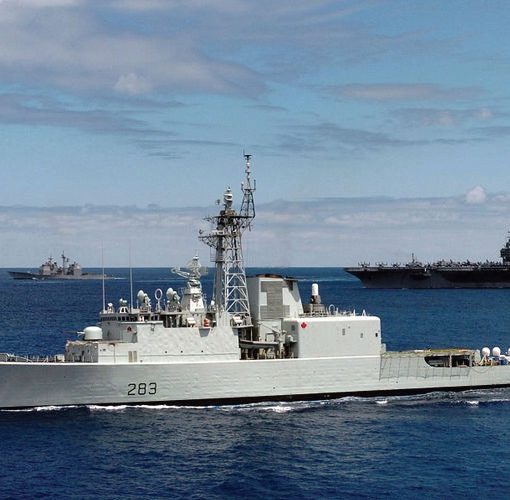Using the term ‘Battle’ for the protracted struggle in the Atlantic during the Second World War diminishes the importance of this important series of campaigns that spanned the entire war. I prefer to call is The Atlantic War, as a counter to the often used term The Pacific War. As with all maritime warfare, it was a series of engagements that achieved their results through a process of attrition and exhaustion.
Canada’s principle contribution to the Atlantic War was the provision of escort groups for the protection of merchant convoys to and from the United Kingdom. Canadian escorts also escorted convoys to other destinations, but the vast majority were of the ‘Slow Convoy’ or SC designation. The SC series of convoys was introduced in August 1940 to provide a system of protection for slow merchant ships (7.5 knots minimum, a speed often not achieved), which had previously been sailing independently, with disastrous consequences. Sydney, Cape Breton, was chosen as the western terminus to help ease congestion on the port of Halifax. SC-1 sailed on 15 Aug 40. During the winters of ‘41 and ‘42 the SC convoys were shifted to Halifax, due to ice in Sydney harbour and its approaches. In Aug 42, when the terminus for the HX series of convoys was shifted to New York City, the SC convoys were moved to Halifax, with a temporary interval where they also originated from New York between Sep 42 and Mar 43.
Of the 177 SC convoys, only three failed to reach their destination. SC-52 lost four of its 34 ships to U-boats in Oct 41 and, with prospects for continued heavy opposition, was returned to Sydney by a tortuous circumnavigation of Newfoundland. SC-62 and SC-63 were scattered by bad weather in Jan 42 and completed their voyages without loss as independently routed ships.
The ‘Battles of the Atlantic’ for the RCN most often revolved around the struggle to protect convoys. In all, only 29 of the 177 SC convoys were attacked by U-boats and only 145 ships were lost from the total of 6,806 ships escorted (2.1%). Included in the total number sunk were: seven ships lost in collisions, six that sank in storms, five that were wrecked on shore, two sunk by aircraft, and one sunk by a British minefield. All others were the victims of u-boats. The number of attacks is quite misleading. The relatively low loss rate was mainly made possible by intelligence and evasive routing, without which losses would have substantially exceeded the 3% rate considered to be unsustainable. Up to the end of Mar 43, the loss rate for intercepted convoys was 13.3% (138/1034). The loss rate for all the 29 SC convoys attacked during the war was 12.3% (145/1175). Additionally, five other ships were damaged. Also, a large number of ‘stragglers’ were sunk when they dropped out of convoys; these losses were not counted against convoy losses. Likewise, a number of ‘rompers’, ships that detached from the convoy to move ahead independently, were lost that were also not counted.
The worst single-convoy losses occurred in Oct 40 when convoy SC-7 lost 15 of the 34 ships under escort (44%). Clearly, when U-boats were able to engage a convoy, they inflicted losses completely beyond the ability of the Allies to sustain. The key, therefore, was not to engage in a series of tactical battles the Allies could not win but to avoid engagements whenever and wherever possible. However, as the number of operational U-boat increased, the prospects for evading them diminished. In a situation report from Admiral Sir Percy Noble, C-in-C Western Approaches, sent to the Admiralty on 29 Sep 42, the spectre of outright defeat was raised. He wrote:
It has always been recognized that the Atlantic lifeline is the vital area in this war – in fact, the war could be lost in the Atlantic … As it appears to me, the enemy will shortly be in a position to attack every convoy, and the amount of protection that we shall be able to afford the convoys cannot be described as adequate. I can see no remedy except the provision of more destroyers or reasonably fast escort vessels with good endurance and more aircraft.” [Emphasis in original text.]
Without the inestimable advantage of signal decryption, the Atlantic War would have been lost long before the so-called ‘Turning Point’ was reached in July 1943. The ability to evade the enemy prolonged the decisive moment until sufficient forces could be gathered to win a series of battles outright that upset the enemy’s risk-reward assessment of the situation. However, ‘winning’ did not mean achieving outright command of the sea. The enemy continued to resist at sea by all means at their disposal until the very last day of the war. In fact, merchant vessels were sunk on both the opening and closing day of the ‘War in Europe’, and many more were sunk by the vast number of mines, both Allied and Axis, that remained a serious and persistent threat for many years. Mines from the Atlantic War are still occasionally washed up on shorelines, including Nova Scotia’s, and brought up in the trawls of fishing vessels.


